FIRE!
FANTASTIC FACTS ABOUT FIRES AND FIREFIGHTING
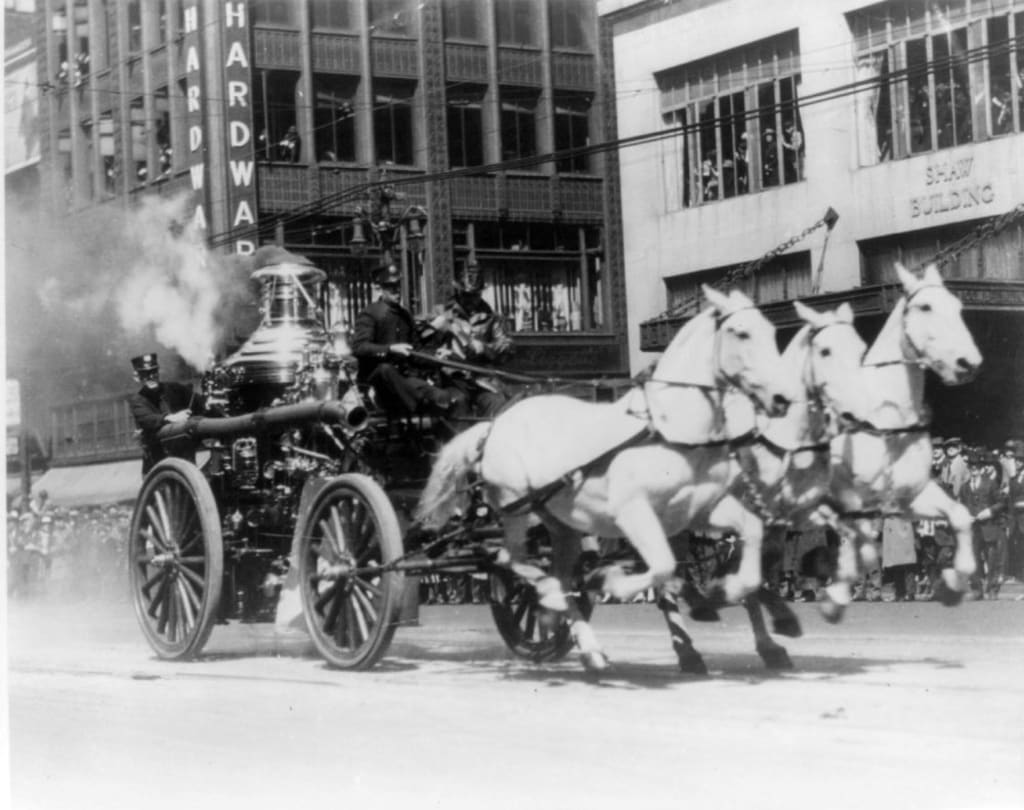
Nothing can empty a building faster than someone yelling the word FIRE! The history of fires and firefighting is filled with unbelievable stories and fascinating facts The story is a tribute to the firefighters who developed innovations in the fight against fire and risked their lives in the line of duty.
Throughout history there have been many fires and many methods for putting out those fires. The “Great Fires” have several consistencies; the speed at which the fire spread, the difficulty in containing the fire and the struggle to extinguish the fire. Each fire brought changes in how cities were rebuilt from the ashes. Each fire also brought changes in firefighting methods. The growth of insurance companies and man’s resistance to change is very much a part of the story of firefighting. For a brief 60-year period between the introduction of the external combustion steam engine and the internal combustion automotive engine that replaced it, the fire horse was the hero of fighting fires!
MRS. O’LEARY’S COW – NOT GUILTY!

The Great Chicago Fire of 1871 started in a barn on the O’Leary property at 137 DeKoven Street, there is no evidence it was caused by the poor woman’s cow kicking over a lantern. That story was made up by newspaper reporter who later admitted he did so because he thought it made for more “colorful” copy. Modern researchers instead have come up with a hypothesis that it may have actually been started by a transient smoking in the barn and inadvertently setting the hay inside on fire. Most of the city’s buildings and sidewalks were made of wood and roofs were tar and shingles so the fire spread quickly.
THE EQUINE EPIZOOTIC EPIDEMIC OF 1872
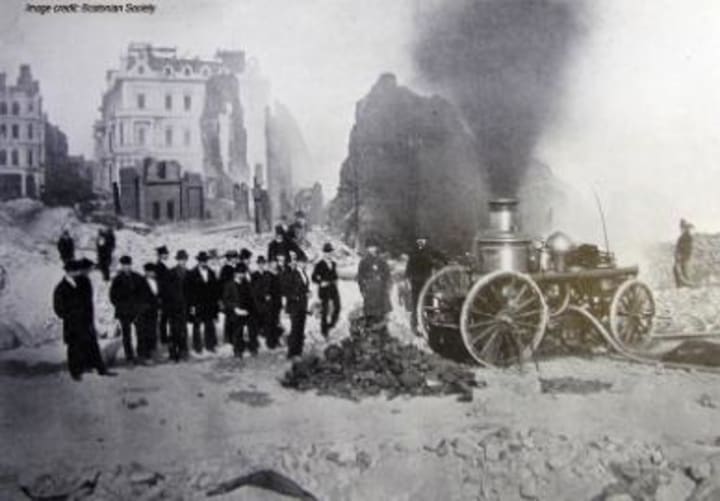
Equine influenza is a highly contagious virus and can infect up to 100% of exposed horses. Fortunately, there is now an effective vaccination for equine influenza. In 1872 equine influenza spread across America from New England to California in only ninety days. All commerce ground to a halt. Coal could not be delivered for locomotives, men had to pull carts and wagons by hand and trains and ships could not be unloaded for delivery. The epizootic contributed to the financial panic of 1873. In Boston there was a great fire and, without horses to pull the fire apparatus vehicles, the fire destroyed 776 buildings across 65 acres of land, with the assessed value of the properties at nearly $13.5 million (about $290 million in 2021 dollars) and personal property loss of $60 million dollars (about $1.2 trillion in 2021 dollars).
SAN FRANCISCO EARTHQUAKE OF 1906 - EVERY DISASTER IMAGINEABLE
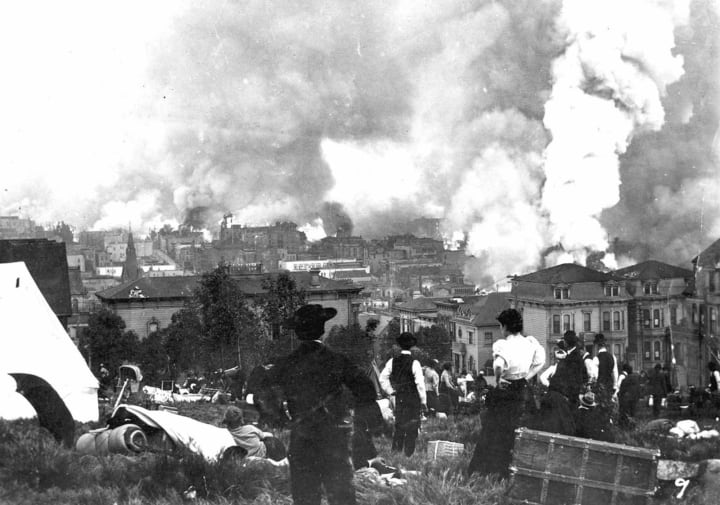
On April 18, 1906 San Francisco experienced an 8.3 magnitude earthquake at 5:12 am. It was centered along the San Andreas Fault. Collapsed buildings and broken chimneys led to several large fires and soon there was a city-wide holocaust. Water and gas mains were ruptured. Leaking gas caused the fires to spread quickly. The entire alarm system went out at the first shock so not one alarm was ever sounded. The Fire Chief was killed in the initial quake making leadership a challenge. The main water reservoirs for the city were along the quake's "fault line" and were destroyed. Water had to be sucked from the cisterns that were soon dry. Near the waterfront fresh water was taken off ships for the engines. There were so many steam engines working that the pressure pulled the wooden water mains right out of the ground. They sent 13 of their 28 pumpers down to the ocean for the water supply and the engines continued pumping for 8 days. They were unaware what the salt water would do to the inside of a boiler and all 13 were ruined. San Francisco was a classic western boomtown before the quake and fire and had grown in a haphazard manner since the Gold Rush of 1849. After the fire there was a push to build steel-framed, Class A buildings.
FIRE SALE
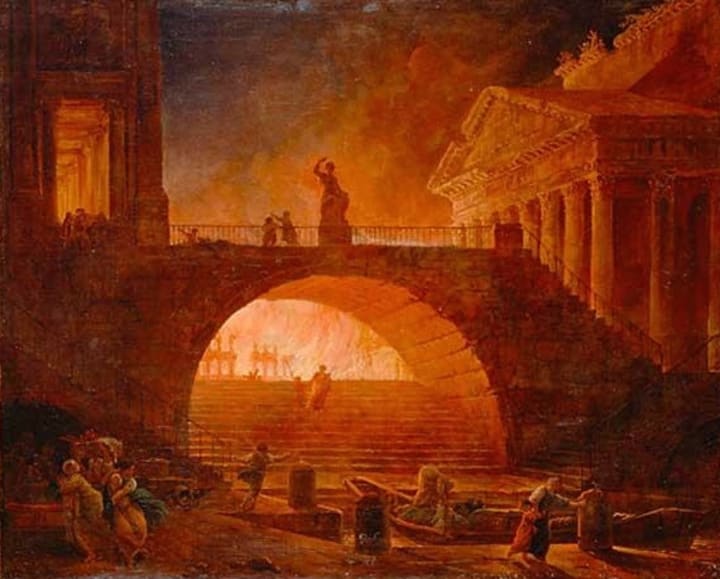
The term “fire sale” may have originated in ancient Rome. There were many Great Fires in ancient Rome so it was just a matter of time that systems of insurance would develop. Marcus Licinius Crassus (115 BC – 53 BC) was one of the 10 wealthiest people of all time. When an area of Rome caught fire, Crassus’ firemen would arrive and do nothing to put out the fire. He would negotiate a price to pay for all the property threatened by the fire. The price would go down by the minute as the fire raged. Finally, when property owners agreed to sell at his “fire sale” prices would his fire fighters put out the fire.
FIRE FIGHTS
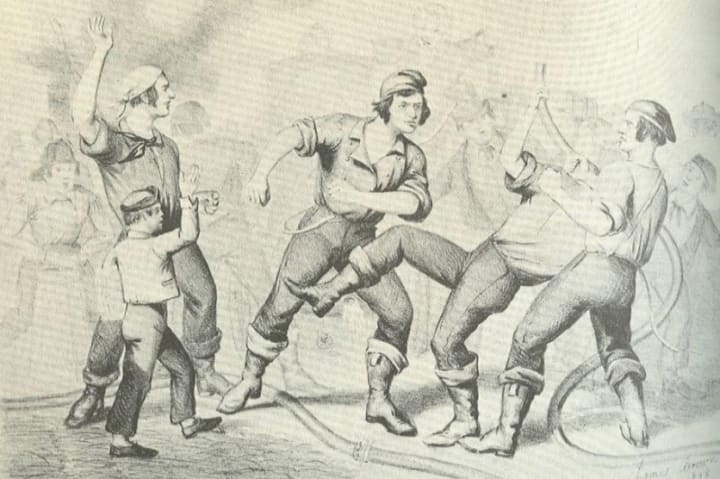
Volunteer firefighters were the most virtuous members of the early American Republic. George Washington, Alexander Hamilton, John Hancock, Sam Adams and Paul Revere were all volunteer firefighters. American firefighting was initially a system of fraternal organizations. Eventually many of these groups were hired by insurance companies or they were volunteers who wanted to prove how tough and manly they were – probably not the best motivations for putting out fires. Volunteer fire companies raced each other to be the first to put water on a fire. Adversaries prevented other firefighters from getting to the scene too rapidly by “accidents” or they would recruit “plug-uglies” to disable the apparatus of their opponents. When different groups of firefighters met, they were more often ready to fight each other than to fight the fires. It was not unusual for a building to burn to the ground while two or more companies of firemen battled to see who should use the nearest hydrant or cistern. Violent brawls brought the attention of local gangs, which began associating themselves with firefighter units. In Philadelphia a gang called “The Killers” joined the Moyamensing Hose Company in the 1840s. In 1856 a confrontation in Baltimore resulted in 7 deaths. Eventually cities realized this was not the best way to fight fires. Cincinnati, Ohio was the first city in America to have a regular, civil fire department. It was the beginning of turning firefighters from a public menace into national heroes.
THE ORIGIN OF THE FIRE PLUG

Until water mains were invented, firefighters had to rely on wells, rivers, ponds and reservoirs for water. If one of these wasn’t nearby, the building burned to the ground. In the late 1700s to early 1800s water mains were built in cities by using hollowed-out wood log pipes. The water mains leaked and clogged but they were better than nothing. These water mains were also used as a source of water to fight fires. Firefighters would dig down, find the log pipe and auger a hole into it. Water would fill the hole they had created by digging to get to the pipe thus creating a “wet well” that could be used for dipping buckets or pumping water out. After the fire was extinguished the pipe would be sealed with a wooden plug and the location marked in case of future need. This is where the term “fire plug” originated. Water officials say they believe that a handful of wooden water mains are still in use in South Dakota, Alaska and Pennsylvania, among other places.
THE HORSE SAVES THE DAY
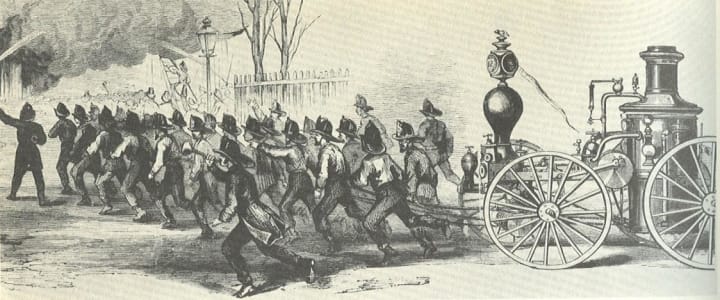
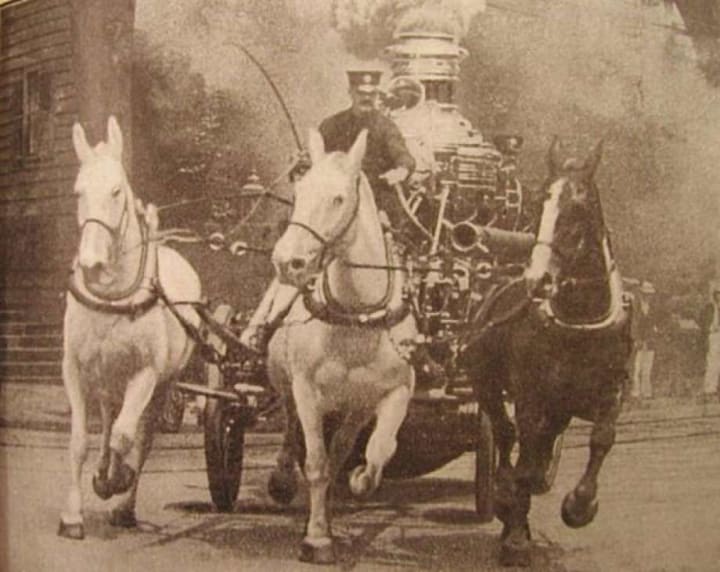
Starting in Cincinnati in the 1850s, every major city switched over to steam-powered fire engines. The steam engines were heavy. The tongue on the steam pumpers stuck out in front six feet. Many streets were not paved in those days and it took approximately 20 men to pull the steam engines with 7 or 8 more men pulling the hose cart. These steam pumpers were much too heavy for men to pull them to the fires in time to be useful so it seemed logical to use horses to pull the vehicles. At first there was resistance to the use of horses in America. All the apparatus in use had been especially designed and constructed to be drawn by hand. The substitution of horse power for man power in the department would have required so few men that the social and political features of the fire department would have been weakened. There would also have been a heavy expense involved as new apparatus would have to be purchased and appropriations made for the construction of stables, as well as to defray the cost of remodeling the houses and the cost of feed and harnesses and of course, horses. Not until paid departments were created did the horse have an established part in fire protection. The paid fire department came a few years before the Civil War. The typical horse -drawn “steamer” could throw as much as 900 gallons of water per minute the length of a football field. Firefighting was now faster and more efficient due to the speed and strength of the horse. To this day many fire departments fondly remember the first horse purchased by the fire department.
TALL BUILDINGS AND SHORT LADDERS

As buildings rose to 5, 7, and even 10 stories, firefighters had to figure out how to keep up. In 1882 the Fire Department of New York purchased French-made scaling ladders called Pompier Ladder; short ladders with hooks on one end that could be moved up floor by floor. The Pompier ladders were in use until 1996!
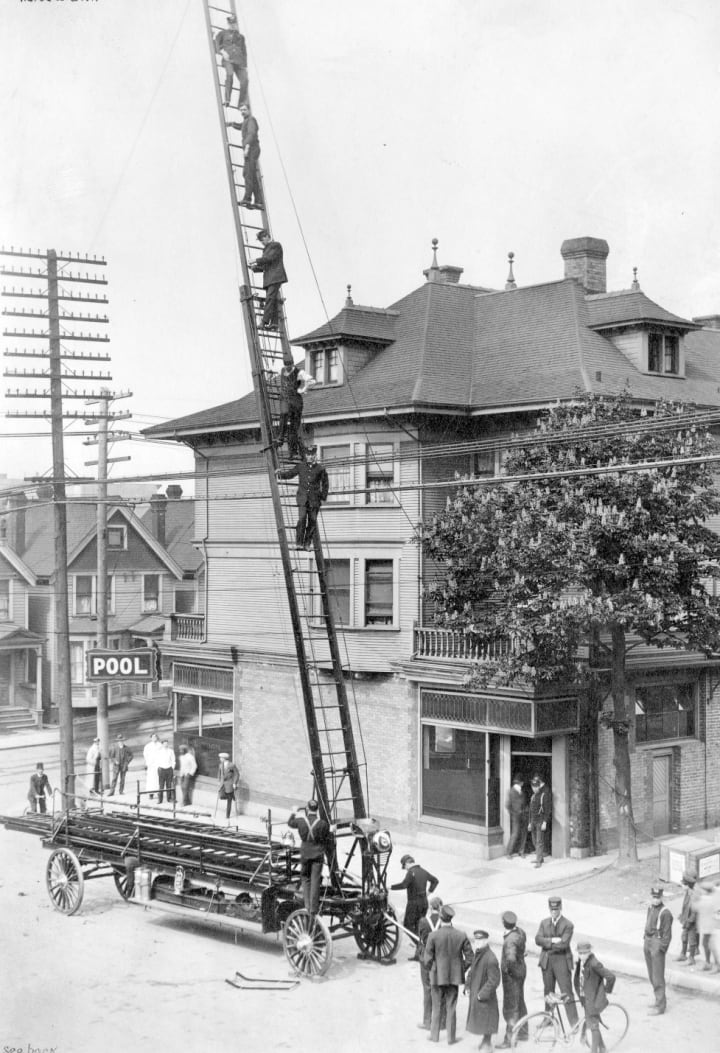
For many years inventors had tried to develop a hook and ladder truck that would effectively reach the upper levels of contemporary buildings, but initial attempts at aerial ladder trucks were often disastrous. Too heavy or too unstable, these horse-drawn trucks were either unable to reach fires in a timely manner or did not function well at the scene of a fire. In several cases, these early models cost the lives of firefighters who scaled their unsafe ladders. Then, in 1868, Daniel Hayes developed a truck with an aerial ladder that could extend as much as 85 feet in height. Today aerial ladders can reach as high as 130 feet
RUNNING BOARDS
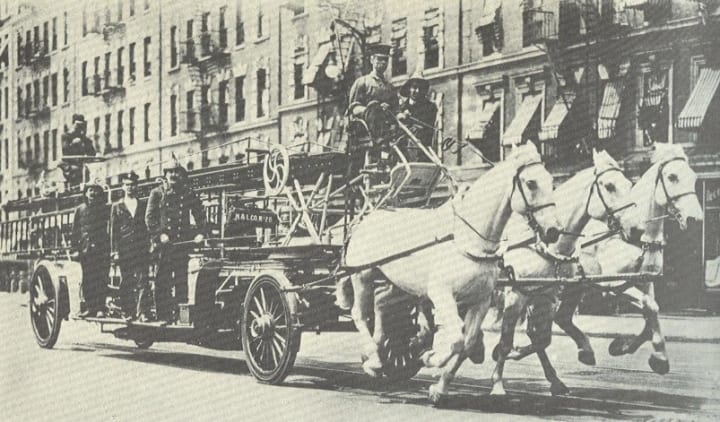
Although the horses transported the apparatus to the fire, the firefighters still arrived by foot. Eventually running boards were installed on the sides of the ladder trucks, making it possible for the firefighters to ride to the scene of the fire. The name “running boards” came from the fact that they took the place of firefighters running to the fire. This improved a firefighter’s ability to fight the fire once he arrived, no longer exhausted from the run.
THE INSURANCE PATROL
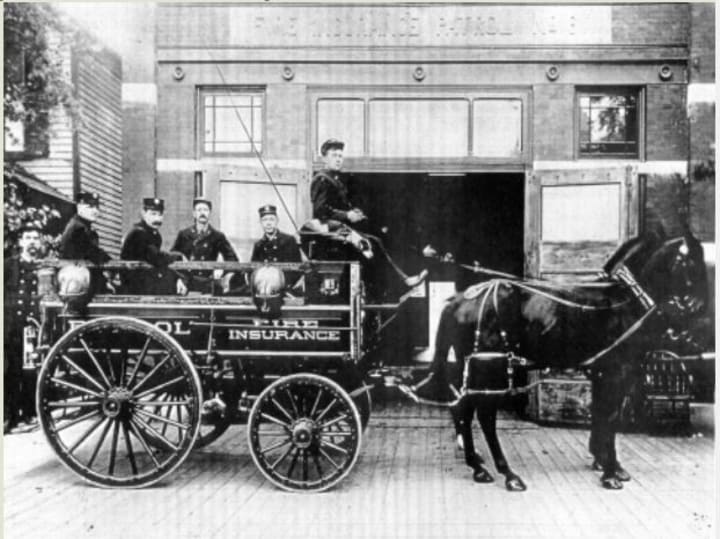
In the early days of firefighting, insurance companies and fire departments worked together at a fire scene. Fire patrols were organized by insurance companies to cover a neighborhood and report any fires that occurred, inspect buildings for fire hazards, and work with the fire department to prevent loss of life and property. Patrol wagons were equipped with rubber blankets to protect property from water damage, fire extinguishers, and buckets to squelch small fires and would pump water from cellars and mop it up from roofs after the fire was extinguished.
THE QUICK HITCH HARNESS
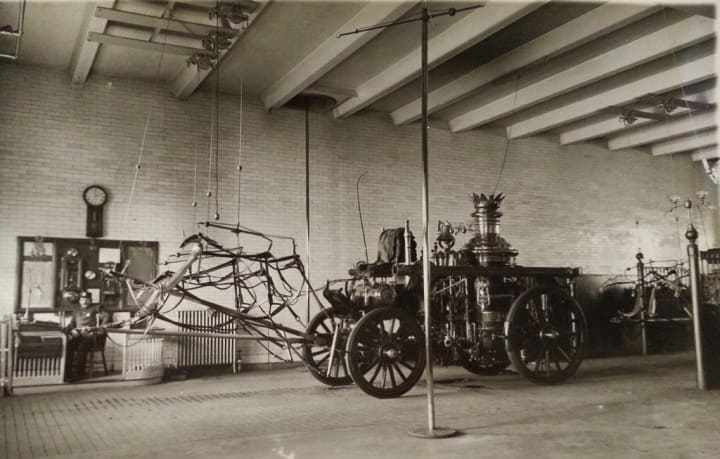
Harnessing a horse takes time. Harnessing the many horses needed to pull all of the vehicles to a fire was very time consuming. Many fire chiefs and firemen invented various versions of a quick hitch harness; of these, the harnesses invented by George Hale and Charles Berry are the best known. The entire harness was attached to pole and whiffletrees and held high above the floor upon a swinging frame, operated by a pulley which permitted it to be lowered instantly, the frame swinging upward as soon as it was tripped by the harness dropping upon the animal's back. Two motions harnessed a horse-the thrust of the open collar together, another movement of both hands simultaneously snapping reins into the bit rings. When the driver leaped to his seat and seized the lines, they were ready to roll out of the firehouse at great speed.
BELLS AND GONGS

Prior to horse-drawn fire vehicles, men would run in the streets with bells or bugles to clear the way for the firemen and apparatus. When horses were first used to pull fire vehicles, there were already so many tinkling bells on various vehicles in the streets that loud, gong type bells were put on fire vehicles. These were often mounted on the floor board and activated by a foot pedal.
SLIDING POLE
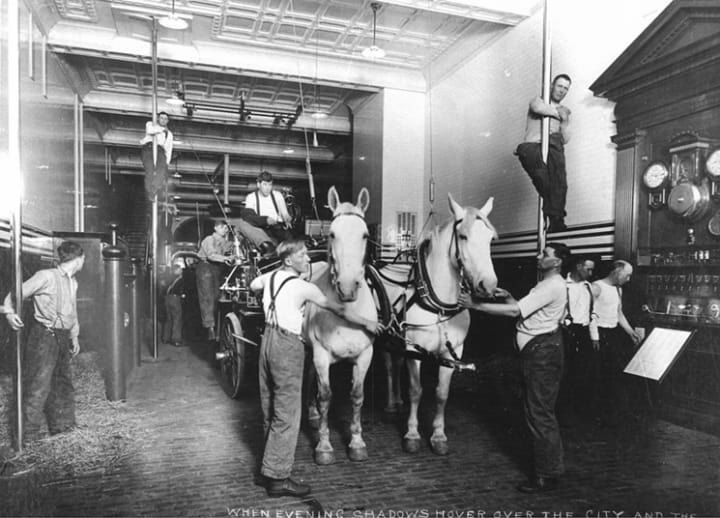
In 1880 the Boston Fire Department installed its first brass pole and it became a standard for fire stations across the United States shortly thereafter. The majority of firehouses in the nineteenth century were two or three stories. Typically, the horse-drawn fire carriages and horses would occupy the first floor, the second floor would be the firefighters’ sleeping quarters, and, in some cases, a third floor would serve as a hay bale storage unit to feed the animals. Often, when the firemen cooked meals on the second floor, curious horses would ascend the stairs into the living quarters; as horses typically don't descend stairs, they would then be stuck there. To solve this issue, firehouses began installing narrow spiral staircases that the animals couldn’t access. This, however, led to a more pressing issue: when an alarm rang, anywhere from ten to twenty firefighters would all have to simultaneously scramble down these narrow, spiral staircases to get below. This impeded response times when every second counted. The firepole saved valuable minutes.
OUT OF THE STATION IN 45 SECONDS!
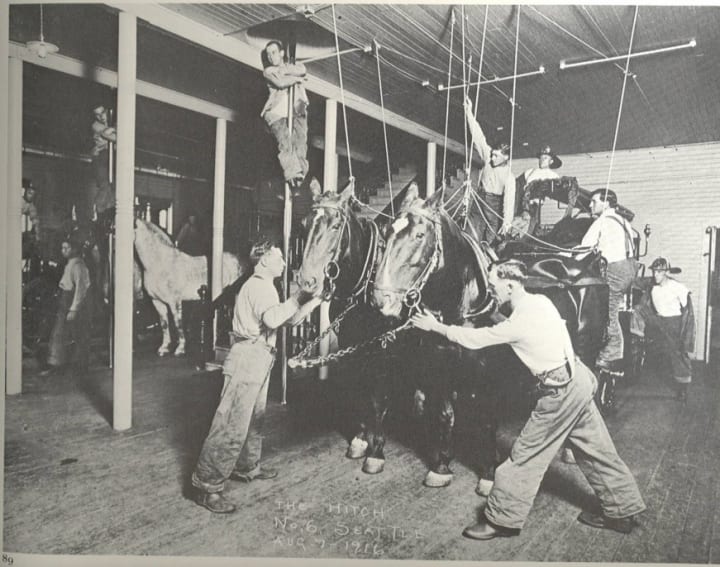
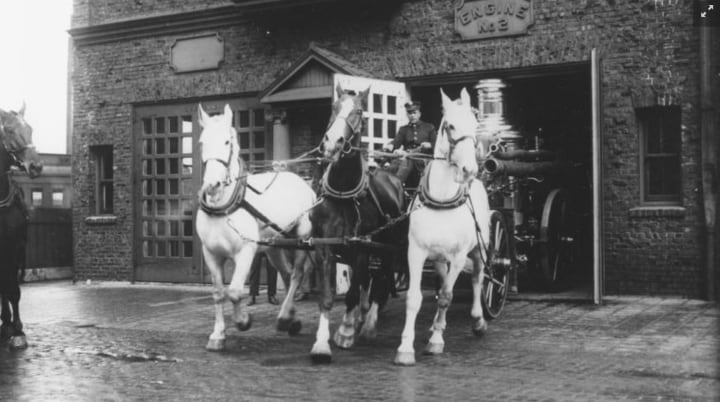
At the first clang of the gong the men slid down the pole and the station doors opened, lights came on and stall doors were automatically released. The trained horses trotted to their apparatus and backed into position under their harness – they were in position before all of the men were down the pole. The engineer lifted the damper, flipped a match into the boiler furnace, ignited the wood shavings or kerosene-soaked cotton waste and they were out of the firehouse. Most companies could leave the station in 45 seconds! Smoke, sparks, gongs and horses racing to the fires was thrilling to watch! Horses galloped at full speed through the congested traffic, often on slippery streets. They had to navigate trolley tracks, mud, ice, snow and tight corners. Frequently scores of youngsters, running and on bikes, followed the engines.
FIRE DEPARTMENT DOGS
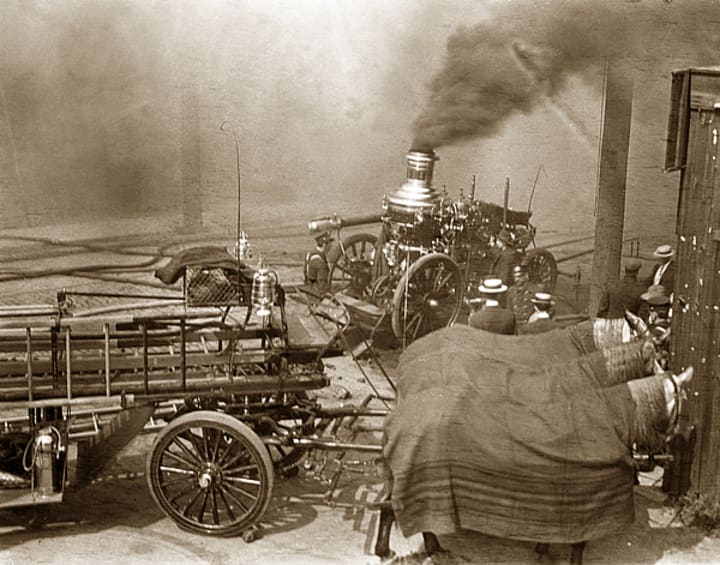
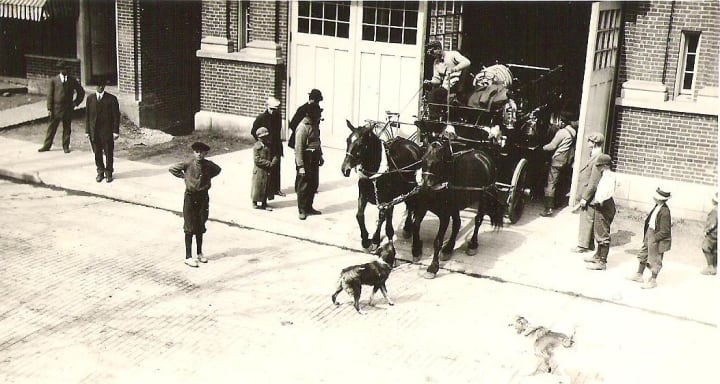
During the long hours at the fire, horses were required to stand patiently despite the heat, flames, sparks, flying glass, steamer smoke, whistles, bells, more galloping horses arriving, yelling men, screaming people, crashing walls, icy spray in their faces and milling spectators. Dogs often travelled with the fire departments to stay with the horses in order to guard them. Most stations had mutts but Dalmatians were often seen. When the fire department left the station in route to a fire, the dogs were the first out the door, barking at people in the road to move them to safety. Once the wagon was in the road and rolling to the fire, the dogs would make sure the wagon never had to stop for pedestrians. Dogs were the first sirens. Once they arrived, there was still the matter of the fire and how the horses reacted to it. Often fire is scary for animals, but the presence of the dogs would ease the stress of the situation on the horses. Guarding the wagons from theft was another job they had once the fire department arrived.
HORSE COLLEGE
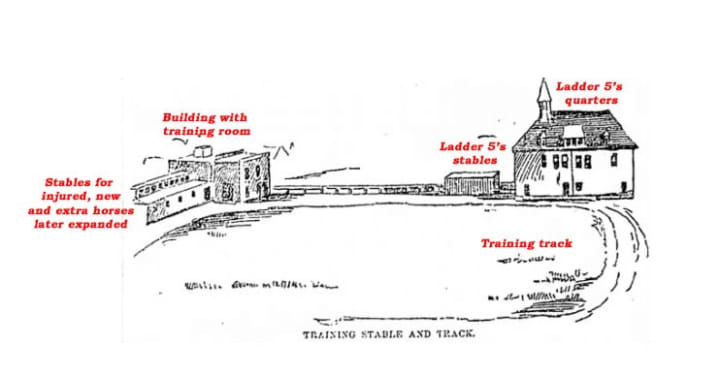
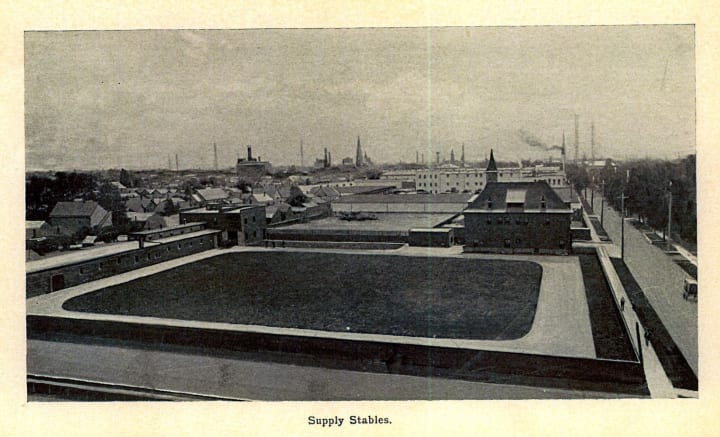
Most horses in fire departments had “on the job” training. In the firehouse, horses were trained to respond to the alarm by repeating the process of ringing the alarm, putting the horse in position and putting on the harness. Horses were teamed with experienced horses when it came time to pull apparatus. Detroit however, had a “Horse College” to train and care for their horses; the horse college was well known and widely respected.
HORSE NO. 12 - WASHINGTON DC
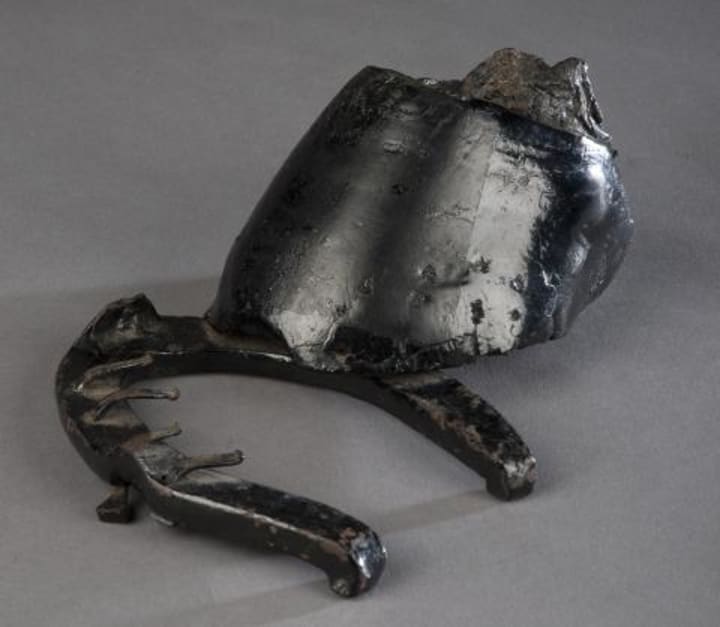
On March 30, 1890, in Washington, D.C., a hose cart and a heavy steam engine collided when racing to a fire yet, they were able to continue on their way to the fire. The driver of the hose cart noticed that one of his two-horse team, Horse No. 12, was limping. When they arrived at the fire. the driver made a shocking discovery. The animal had lost its left rear foot, apparently run over and cut off in the collision with the heavy engine. Despite this, the valiant horse had galloped to the fire—nearly a mile. Through the tears of attending fire fighters and policemen, the horse was quickly put down. Conditioned by the chaos of the city's emergencies the horse did his job. The horse was lauded as an "equine hero". Cauterized and preserved with a coat of shiny black enamel, the hoof of Horse No. 12 lived on as a memorial in the District of Columbia Fire Department. The Smithsonian exhibited the hoof as a loan, and later accepted it as a gift through the department’s chief engineer. Its placement in the museum, perpetuates the bravery and devotion of Horse No, 12.
ONCE A FIRE HORSE ALWAYS A FIRE HORSE
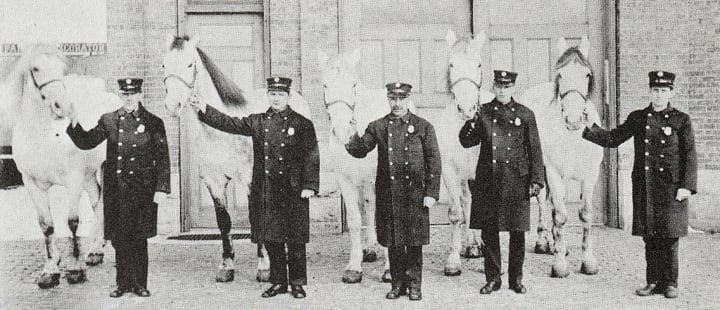
A milkman was unaware his old horse had been a member of a fire department until one day an engine passed as he was delivering milk on the Bowery. Instantly the animal took off behind the steamer, while milk cans flew out of the milk wagon.
Tom a horse in the city of New York Fire Department had served so well that they granted him a pension, specifying that he be kept in his own station. But Tom was not ready to retire. When the alarm would sound he would vigorously kick his stall and would hurry to his harness and then when led aside he would return slowly and voluntarily to his stall.
WORLD’S FAIR FIREFIGHTING EXHIBITION
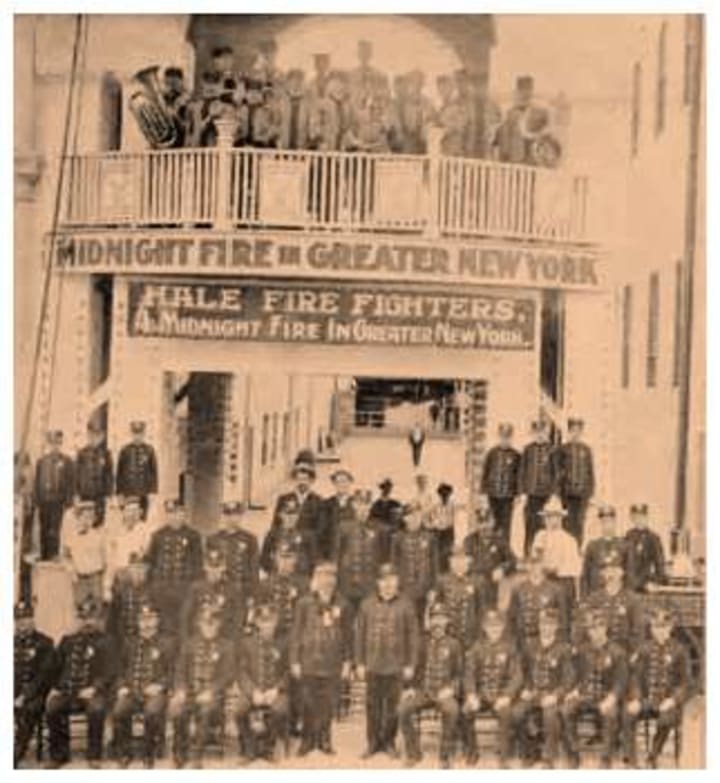
There was a very popular exhibit at the 1904 St. Louis World’s Fair featuring firefighting. The attraction was operated by George Hale, legendary Kansas City Fire Chief. He was quite the celebrity after receiving first prize at the 1893 International Fire Tournament in London where he astonished the world with the amazing time of hitching his two horses in less than 15 seconds. The building at the Fair contained a 5,000-seat auditorium. The show began with information on how the fire wagons worked as well as draft horses leaping through special effects fire. The set switched to a New York City street and illustrated how the brave firefighters were alerted, responded and dealt with a 6-story building fire. The interesting fact for this attraction was that there was no fire used in this spectacle. It was all done with special effects. At the end, the building collapsed after the rescue of its inhabitants. After the show, the crowd gazed at a collection of old and new firefighting equipment. New York sent 2 fire wagons once pumped by George Washington and Benedict Arnold.
RESITANCE TO A MOTORIZED FIRE DEPARTMENT

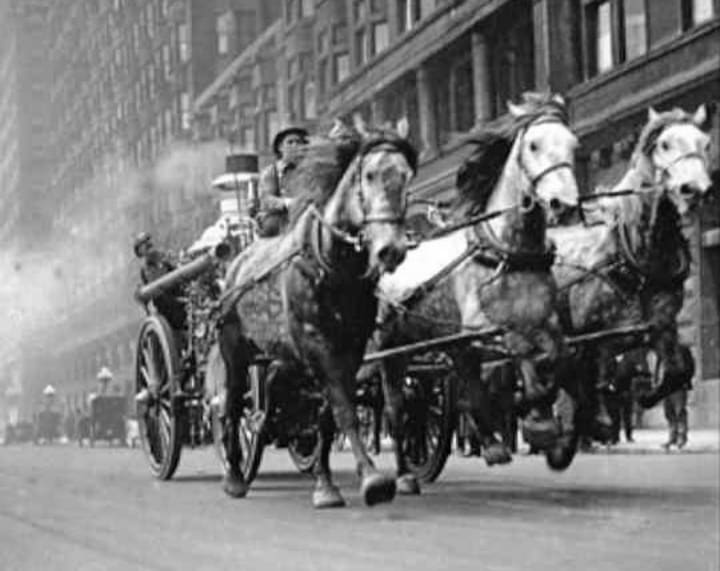
In 1911 the following “ad” was placed in the New York Times: “Once more, the picturesque is to yield to the utilitarian. That thrilling sight – three plunging horses drawing engine or hook and ladder – one of the few thrilling sights to be seen in our prosaic streets, is soon to become a thing of the past. Within the next five or six years, there will not be a fire horse in Greater New York. The gasoline motor will do the work of these old favorites.” As much as there was resentment to the horses being brought into the firehouse, there was even more resentment to them being replaced by motorized vehicles. Many cities held “last runs” through the city streets and thousands of people came to say a sad farewell to the horses. As Loula Long Combs wrote in her book, My Revelation,
“I wish I had the great gift of a painter of word pictures that I might be able to give you a faint idea of the most thrilling of all horse-drawn vehicles, the fire engine. It thrilled the very young as well as the very old. In the language of today, you who have never seen a horse-drawn fire engine, aint seen nuthin.”
"There is nothing to it anymore. When they took the horses away, the pep and fun went out of the department. It was the sorriest day in our history.” quoted one Baltimore fireman who quit the day the horses left the station.
To learn more about the amazing early history of firefighting , you can read a book that I did the research for: The Fire Horse: A Historic Look at Horses and Firefighting
About the Creator
Mary Chris Foxworthy
Mary Chris combines her life-long love affair with horses with a passion for keeping history alive. She is an active competitor at horse shows and is known for her work as a research writer for the Equine Heritage Institute.






Comments
There are no comments for this story
Be the first to respond and start the conversation.